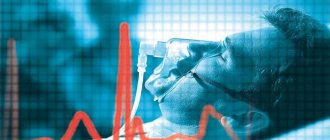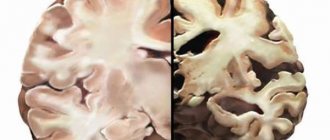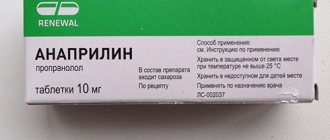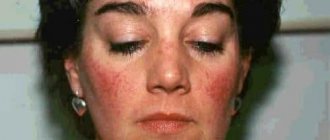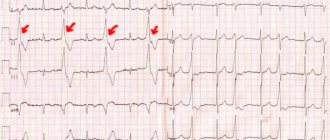Stroke itself is a dangerous disease that significantly worsens the patient’s well-being and often leads to disability. But the consequences of pathology are no less dangerous. One of them is pneumonia after a stroke, which develops under the influence of unfavorable circumstances. Pathology is detected in at least 30% of patients, and the type of brain damage does not matter.
So, why might pneumonia occur after a brain hemorrhage?
Causes of the disease
Pneumonia
Pneumonia is diagnosed in half of patients who have had a stroke. The likelihood of such a complication increases if the patient is over 65 years of age and has previously suffered from pneumonia or diseases of the cardiovascular system. Excess weight contributes to the development of pathology.
Respiratory disorders are almost always diagnosed with severe brain damage, since this is accompanied by a decrease in immunity and facilitates the penetration of microorganisms into the lower respiratory tract.
Pneumonia after apoplexy is recorded in people who are in a coma, as well as those who have been on artificial ventilation for a long time. In addition, the functioning of the organ is impaired due to prolonged hospitalization in a supine position.
In 20% of people, pneumonia develops immediately after hospitalization, in 50% the disease occurs after 3 days.
In most cases, the causative agent is bacteria, but if the patient receives antibiotics and glucocorticosteroids, fungal infection is possible.
The following factors contribute to the occurrence of infection in patients:
- violation of the act of swallowing;
- performing tracheal intubation;
- hypoglycemia;
- uremia;
- chronic heart disease;
- smoking.
Smoking
The risk of respiratory disorders increases in patients whose consciousness on the Glasgow scale is assessed as less than 9 points, as well as when undergoing mechanical ventilation for more than 10 days.
Why do the lungs become inflamed during a stroke?
The pathophysiological causes of pneumonia after a stroke include:
- depression of consciousness;
- central respiratory failure;
- hypodynamic changes in blood flow in the pulmonary circulation.
Massive brain damage causes damage to the body's self-regulation and self-defense mechanisms. The drainage function of the lungs is impaired, the cough reflex is reduced, the normal microflora is replaced by highly virulent strains of nosocomial infection, which contributes to the rapid development of the disease.
Long-term mechanical ventilation after a stroke or aspiration are also direct causes of pathogenic flora entering the respiratory tract.
The most common causative agents of pneumonia after a stroke are:
- Staphylococcus aureus;
- pneumoniae streptococcus;
- Pseudomonas aeruginosa;
- Klebsiella;
- enterobacter;
- Escherichia coli and other gram-negative pathogens characteristic of nosocomial pneumonia.
Development mechanism
Pneumonia is associated with impaired blood flow, which leads to stagnation of fluid in the lungs. This causes the growth of pathogenic microflora.
When a person has a stroke, there are two types of infection possible: aspiration and congestion. The first type is associated with a violation of the act of swallowing. As a result, liquid or pieces of food enter the bronchi, which disrupts air circulation.
The congestive form occurs due to the patient's supine position. The reason for its appearance is poor circulation in the respiratory system and compression of the chest. These factors impair the functioning of the lungs, which contributes to the accumulation of sputum in them.
Causes and types of pneumonia
The high incidence of inflammation in the pulmonary system after a stroke has several factors. After an ischemic attack, significant brain damage is observed. As a result of depression of consciousness, the body’s defense mechanisms lose their natural rhythm, the brain does not control the functionality of organs and systems, and does not regulate the course of biochemical processes.
Factors that increase the likelihood of developing inflammation in the lungs in the period after a stroke are the following:
- deterioration or loss of the swallowing reflex;
- decrease in the speed of blood movement in the lungs and bronchi;
- lack of delivery of necessary substances and oxygen to the respiratory organs;
- problems in the bronchial drainage system;
- beneficial microflora is replaced by pathogenic ones;
- advanced age;
- excess weight;
- the presence of pathologies of the bronchopulmonary system;
- unconscious state;
- prolonged mechanical ventilation;
- long static position;
- the influence of certain medications - H2 blockers and others.
Early pneumonia can develop as a result of insufficient treatment of equipment, medical procedures (ventilator-associated) or as a result of improper care. However, the main cause of this complication is considered to be fluid stagnation and the lack of normal functioning of the diaphragm. At the same time, prerequisites are created for the active life of pathogenic infectious agents that can provoke pneumonia.
Aspiration pneumonia occurs when food debris enters the respiratory tract. As a result, lung tissue is damaged and loses functionality. With food, pathogenic microorganisms can enter the pulmonary system, which, actively multiplying, provoke inflammation.
If food enters the bronchi, they become blocked. Aspiration pneumonia is clinically similar to poisoning. First, a debilitating cough occurs, then the temperature rises. If pieces of food enter the large bronchi and block them, the cough becomes very painful and breathing is impaired.
Symptoms of pneumonia
Increased body temperature
The main sign of infection is difficulty breathing. The patient's temperature rises to 38 degrees. Chest pain and cough are also noted. During expectoration, purulent sputum is released. The last symptom is also characteristic of other pathologies of the respiratory system, so it is very important that the doctor correctly determines the cause of the appearance of such a symptom.
Diagnostics
To select the most effective treatment for pneumonia in a patient who has suffered a stroke, the following diagnostic measures are carried out:
- General blood analysis,
- Bacteriological analysis of sputum,
- General examination using a phonendoscope,
- X-ray of the lungs.
Late diagnosis is most often caused by the similarity of the symptoms of pneumonia with post-stroke manifestations. Also, X-rays of the lungs are not always informative when an inflammatory process develops in the posterior-basal or lingular zones of the lung.
Diagnostic features
Timely diagnosis is complicated because early manifestations of pneumonia are often confused with neurological disorders. For this reason, the disease is often detected in late stages.
Pathological processes in the lungs are shown by x-rays and ultrasound of the pleural cavity. If congestion is suspected, the patient is given an ECG and echoCG.
To diagnose pneumonia in bedridden patients after a stroke, a blood test is important. When infected, the patient's number of leukocytes and neutrophils increases. However, these indicators are overestimated in any critical condition and do not always indicate problems with the respiratory system. More informative is the study of blood gas composition.
Blood analysis
Therapy is possible only after identifying the pathogen and determining its sensitivity to antibiotics.
Treatment
Treatment of pneumonia should be aimed at eliminating oxygen starvation (hypoxia), inhibiting the development of pathogenic microorganisms and restoring breathing.
Pneumonia during stroke is treated by using:
- Antibacterial therapy. If the disease is at the initial stage of development, the patient may be prescribed Ampicillin or Ceftriaxone. If the inflammatory process in the lungs has advanced development, then its treatment will be carried out by taking Meropenem, Tobramycin or Ciprofloxacin. In order to increase the effectiveness of treatment, you can combine the use of certain antibacterial agents. The duration of antibiotic use may vary and depends on the severity of the disease.
- Oxygen therapy. It is carried out using mechanical ventilation (artificial pulmonary ventilation) and is designed to maintain normal respiratory function. In addition, mechanical ventilation prevents the occurrence of hypoxia, restores the gas composition of the blood and normalizes the acid-base balance in the body.
- Mucolytic, bronchodilator and bronchodilator drugs (Bromhexine, Acetylcysteine, etc.). Such medications help remove mucus from the lungs.
- Immunomodulatory agents. These include Timalin, Dekaris, etc.
- Diuretic drugs. By taking diuretics, you can remove excess fluid from the body and normalize blood pressure.
In order to speed up the process of removing sputum from the lungs, the patient may be prescribed special procedures. This can be a set of breathing exercises that restore breathing functions, vibration or manual chest massage.
5 days after the start of treatment, the doctor must conduct a diagnosis to assess the effectiveness of the therapy. The effectiveness of the treatment course will be indicated by the intensive removal of mucus from the respiratory tract, a decrease in leukocytosis and body temperature.
Important information: What to do when you feel dizzy after an ischemic stroke and how to get rid of dizziness
Treatment methods for pneumonia after stroke
Pneumonia is treated comprehensively. Medicines are selected taking into account the patient’s condition, the causative agent of the infection and concomitant diseases. Therapy includes:
- antibiotics or antiviral drugs;
- antipyretic, anti-inflammatory drugs;
- expectorants, diuretics;
- painkillers;
- medicines to restore blood circulation.
Mechanical ventilation
In addition to these medications, the patient needs medications that support the functioning of the heart and blood vessels. In the absence of fever, immunoreplacement therapy is required.
If respiratory function is impaired, a patient with a stroke is given mechanical ventilation. For severe cases of the disease, detoxification medications are prescribed. If necessary, undergo a course of infusions of native plasma.
After starting therapy, the patient should begin to breathe easier after 36 hours. The doctor, constantly checking his condition, can adjust the treatment by changing medications or increasing their dosage. Recovery is indicated by:
- decrease in the number of leukocytes;
- decrease in temperature;
- reduction of expectorated sputum.
Breathing exercises and chest massage are of great importance in the treatment of patients with stroke.
Prevention
Pneumonia can be avoided if the patient is provided with proper care and a number of important procedures are performed.
To operate the diaphragm and eliminate stagnation, you need:
- Regularly turn the patient over from the right side to the left 6-8 times a day, sit down on the bed, and lay on his stomach.
- Thorough cleansing of the oral cavity: teeth, tongue, gums from food debris.
- Daily massage (3 to 5 times) of the upper third of the chest
- Physiotherapy.
- Inflating balloons, plastic bags, blowing air through a tube inserted into a container of water.
- At home, alternating jars and mustard plasters is recommended.
The patient should lie on a special functional bed with the head end elevated by 30–60°. The room should be regularly ventilated and equipped with a humidifier.
Medical and service personnel must strictly observe the rules of hygiene; all equipment and care products are carefully treated with disinfecting solutions.
A patient weakened by the disease should be protected from any contact with infection.
Untreated pneumonia after a stroke is always fatal. If not treated in a timely manner, the disease can be complicated by an abscess, gangrene, exudative pleurisy or empyema.
Forecast
If the pneumonia is bilateral, the prognosis is negative for patients with cerebrovascular accidents. They rarely survive with this form of the disease. The chances of recovery are greater in patients with minor brain damage, provided they undergo rehabilitation and maintain physical activity.
Elderly people are more likely to suffer complications due to apoplexy compared to young people. Their sputum accumulates more intensely, so respiratory failure occurs faster.
Reasons for the development of complications
The high incidence of post-stroke pneumonia is directly related to the fact that in patients severe forms of cerebral circulatory disorders lead to profound depression of consciousness and breathing, swallowing and cough reflexes. The situation is also aggravated by hemodynamic changes in the blood circulation of the lung tissue, weakened immunity, and a malfunction in the bronchial drainage system. All this contributes to an imbalance in the functioning of normal microflora and its displacement by pathogenic ones.
The vast majority of patients, when admitted to the intensive care unit or intensive care unit, receive so-called hospital-acquired pneumonia, which develops in the first two days from the onset of the acute period of cerebrovascular accident.
Factors that provoke this dangerous complication include:
- Age 60 years and older.
- Excess body weight.
- The patient has been on mechanical ventilation for more than a week.
- Prolonged static position, adynamia.
- History of chronic cardiovascular and pulmonary pathology, uremia and hyperglycemia.
The risk group for the development of complications also includes patients with a reduced level of immune defense and with acute and chronic diseases of the nasopharynx and oral cavity.
Prevention of pneumonia after stroke
To prevent the development of respiratory disorders after apoplexy, it is necessary to pay sufficient attention to the hygiene of the patient and his belongings. People around you should also use antiseptics.
Bedridden patients should periodically change their position. They are recommended breathing exercises and any active movements in bed. The patient's upper torso should be elevated at a 45-degree angle. It is necessary to regularly sanitize the nasopharynx.
Tracheostomy
If a stroke patient is placed on a ventilator, it is important to use tracheostomy tubes made from quality materials.
Stroke and pneumonia – it can’t be worse
A stroke in itself is a serious disease that can easily make a person permanently disabled. What can we say when after one “blow” to health comes a second, no less serious one – pneumonia. The most common development is the congestive version of this disease, which is a complication of a previous stroke.
According to statistics, the incidence of pneumonia after a stroke ranges from 35 to 50%. In approximately 15% of complications, pneumonia causes death. It would seem that a person survived after one illness, but could not cope with the second. Any pneumonia during a stroke has its own reasons; it makes sense to understand them in more detail.
Risk factors
Any disease, including pneumonia after a stroke, has its own causes and risk factors. Such knowledge will help prevent complications and prevent their occurrence in the first place.
Elderly and senile people often experience pneumonia after a stroke. Their lung drainage function is normally impaired, and after a stroke there is virtually no sputum production, especially if the disease is severe. The risk of pneumonia increases significantly after a person turns 65 years old.
Excess weight in itself is a predisposing factor to the development of stroke. In the case of a complication in the form of pneumonia, the chances are much higher. Pneumonia can occur in people who suffered from chronic forms of heart and lung disease before the stroke.
After a stroke, a person can often be in a coma, this contributes to the development of congestion in the lungs. The cause of this condition is a violation or complete absence of sputum outflow.
Sometimes even a conscious patient remains on bed rest, which contributes to stagnant processes in the pulmonary system.
Development mechanism
It is no secret that the prognosis after a stroke is often sad. There are some reasons that trigger the pathological mechanism for the development of the disease. They consist of:
- in a depressed consciousness for a certain time;
- central respiratory dysfunction;
- lack of active movements;
- impaired blood supply to the lungs.
The degree of damage depends on the massiveness of the brain tissue damage, as well as the location where the hemorrhage or blockage of the vessel occurred. As a result, the function of draining mucus from the lungs is impaired in some patients.
The cough reflex or the urge to cough is reduced or absent; it is this that is protective and promotes the discharge of sputum. Microorganisms are replaced by more aggressive ones that can cause disease.
Then it’s just a matter of time and the disease does not keep itself waiting long, the inflammatory process develops rapidly.
Other factors
But artificial ventilation of the pulmonary system after a stroke is not always the cause of the development of the disease. Often there is an infection that is constantly present in the hospital, especially in the intensive care unit. The level of immune defense also decreases, the body is unable to resist infection.
Symptoms of the disease
Diagnosing pneumonia after a stroke, even at the present stage of medical development, can be very difficult. The problem remains open to future generations of doctors. Difficult diagnosis is the factor that contributes to human mortality. In general, manifestations can be easily veiled by the primary disease.
Some symptoms may be noticeable:
- the temperature rises moderately;
- breathing is impaired according to the type of pathological variant of Cheyne-Stokes or Kussmaul;
- as a result of a violation of the cough reflex, there is no sputum production;
- On auscultation, wheezing of various calibers is heard.
Features of aspiration pneumonia
This variant develops as a result of food particles entering the respiratory tract. After this, a segment of the lung ceases to perform its function normally, and the bacteria that are located there rapidly develop.
With aspiration pneumonia, the manifestations resemble intoxication or poisoning. Initially, a cough is noticed, which is painful in nature. The hilar variant of aspiration pneumonia is difficult to diagnose. A high temperature develops and coughing becomes painful. A dangerous situation becomes when a large bronchial tube is blocked by pieces of food.
Symptoms of late variants
Diagnosis of the late version of the disease is much simpler. To make a correct diagnosis, your doctor will need certain symptoms. Among them it is worth noting:
- rapidly developing fever, numbers above 38 degrees;
- in a blood test, the increased number of leukocytes is of interest;
- there is pus in the sputum or discharge from the trachea;
- The X-ray image clearly shows pathological changes in the lung tissue.
Definitive diagnosis
In addition to symptoms, there are some standards for instrumental diagnosis of the problem. Initially, it is worth listening to the chest using a phonendoscope; if pneumonia is suspected, then an X-ray examination of the lungs is prescribed. In addition to stagnant phenomena, the most intense shading center will be clearly visible in the image.
Sputum or bronchial washings are subject to examination. This analysis will allow us to determine the type of pathogen, after which its individual sensitivity to antibacterial drugs is carried out. This analysis will subsequently allow the doctor to prescribe effective treatment.
Treatment
In case of pneumonia, which could be complicated by a stroke, measures are aimed at eliminating hypoxia as quickly as possible. The tissues must receive more oxygen, this is done through artificial ventilation or the use of oxygen pillows. It is necessary to pay attention that pulmonary edema is often associated, which is why prevention of this condition is carried out.
At the same time, treatment of the underlying disease is carried out, which is prescribed by a neurologist. After establishing the type of pathogen and its sensitivity to antibiotics, appropriate drugs are used. Before this analysis, broad-spectrum antibacterial drugs are indicated. The dose of the antibiotic is selected individually, but, as a rule, they are used in large quantities.
Diuretics are mandatory; they help reduce swelling and prevent pulmonary edema. Cardiac medications and expectorants are indicated. If there are problems with sputum discharge as a result of its viscosity, the doctor may prescribe medications to thin it.
Additionally
After the person’s condition has been stabilized due to a stroke, physiotherapy is recommended. Electrophoresis with potassium iodide is excellent for removing mucus. Exercise therapy under the guidance of an instructor is also indicated; it is mainly aimed at restoring breathing.
While still in bed, the doctor may recommend breathing exercises to the person. If the patient is able to breathe on his own, then he is recommended to inflate balloons in bed. Special drainage provisions are also used to promote the removal of mucus from the lungs. Massage in the acute period is undesirable, but in a mild form it helps remove mucus and is carried out by a massage therapist.
Prevent pneumonia
When there is an understanding of the mechanism of disease development, the development of the disease can be prevented. Based on this, certain preventive measures have been developed, the observance of which will reduce the risk of developing the disease. An approximate list of them can be presented as follows :
- It is worth reducing the pathogenic factor, because the risk of developing the disease largely depends on medical workers and the quality of their duties. In the intensive care unit, in addition to the treatment of instruments and surfaces, sanitation of the bronchial tree is mandatory.
- It is necessary to carefully observe the rules of hygiene, including personal hygiene. Medical workers should adhere to the rules of asepsis and antisepsis.
- The tube that is used for ventilation must be for individual use and must be processed and disposed of after use. The same applies to other instruments that may come into contact with the human respiratory system.
Prevention
There are some things you can do to help prevent pneumonia from developing after a person has had a stroke. Some moments will require effort from the caregiver and staff, but then they will fully justify themselves.
Initially, it is worth ensuring a constant flow of fresh air. This can be done by ventilating the room, but with certain precautions to prevent hypothermia. A person should be covered with a blanket, and in the cold season several.
Oral hygiene is mandatory when a person is unable to cope with it himself; those who care for him help him. To prevent stagnation, the position in bed is changed every two hours. If the patient is in a normal condition, he is given a semi-lying position at an angle of 45 degrees.
Additionally, breathing exercises are indicated, which are carried out no earlier than an hour and a half after the last meal. It is useful to inflate children's balloons. Additionally, a special massage is provided for about three sessions throughout the day.
As stroke symptoms regress, the person needs to be activated, first in bed, and then within the ward. This approach will prevent the accumulation of sputum and prevent congestion.
Source: https://ProLegkie.com/pnevmoniya/lechim/insult-i-pnevmoniya-xuzhe-ne-pridumat
Possible complications
If pneumonia is left untreated in stroke patients, lung function deteriorates, leading to respiratory failure. Death is more likely in patients with a congestive form of the disease.
If respiratory disorders are not treated in a timely manner, the condition of a bedridden patient is complicated by pericarditis, myocarditis and shortness of breath. Mortality increases if the infection spreads to the heart valves and leads to heart defects.
The consequence of pneumonia can be sepsis with multiple hemorrhages. This complication occurs with severe intoxication by the microorganisms that caused the disease. One of the most dangerous conditions that are detected in this case is infectious-toxic shock, accompanied by a decrease in blood pressure.
Difficulties in diagnosis
Even today, with the availability of modern equipment, it is extremely difficult to diagnose pneumonia in patients with ischemic stroke in a timely manner. The main difficulty is that the symptoms of inflammation in the early stages of a stroke are often mistaken for signs of the underlying disease. Late diagnosis of pneumonia leads to the fact that by the time the diagnosis is made, the disease has already taken a severe form or caused complications.
It is much easier to determine inflammation that occurs against the background of improvement in the underlying disease. In this case, the picture is clearer, and doctors quickly navigate the diagnosis. In severe strokes, the symptoms of pneumonia are usually more vague and therefore difficult to identify.
